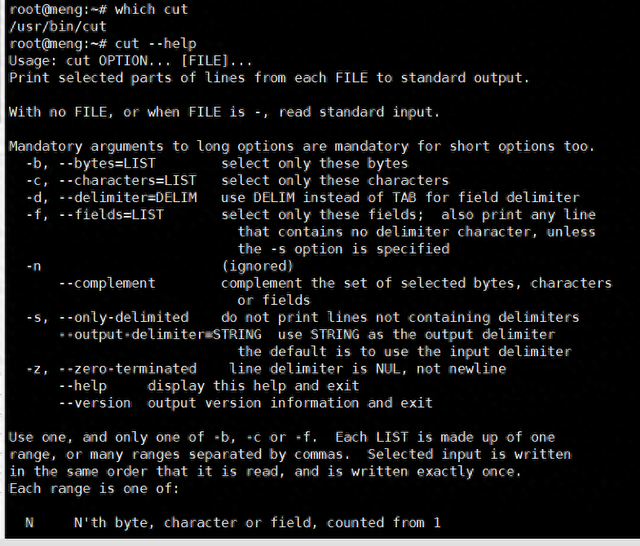linux 操作系统下的cut命令介绍和使用案例
在 Linux 操作系统中,cut 命令是一个用于文本处理的命令行工具,允许用户从文件或管道数据中提取特定部分并将结果输出到标准输出
1. cut 命令简介cut 命令主要用于从文本文件中提取特定的字段、字节或字符。它常用于处理结构化数据文件,如 CSV 或 TSV 文件,能够根据分隔符(如逗号或制表符)提取列。
基本语法bashcut [OPTIONS] [FILE]OPTIONS: 用于指定如何切割文本的选项。FILE: 要处理的文件名。如果未指定文件名,cut 将从标准输入读取数据。2. cut 命令选项选项
描述
-f 或 --fields=LIST
根据指定字段(列)选择数据。
-b 或 --bytes=LIST
根据指定字节选择数据。
-c 或 --characters=LIST
根据指定字符选择数据。
-d 或 --delimiter
指定分隔符,默认为制表符(TAB)。
-s 或 --only-delimited
只输出包含分隔符的行。
--complement
显示所有字节、字符或字段,除了选定的部分。
--output-delimiter
指定输出的分隔符,默认为输入的分隔符。
命令介绍:
root@meng:~# which cut
/usr/bin/cut
root@meng:~# cut --help
Usage: cut OPTION... [FILE]...
Print selected parts of lines from each FILE to standard output.
With no FILE, or when FILE is -, read standard input.
Mandatory arguments to long options are mandatory for short options too.
-b, --bytes=LIST select only these bytes
-c, --characters=LIST select only these characters
-d, --delimiter=DELIM use DELIM instead of TAB for field delimiter
-f, --fields=LIST select only these fields; also print any line
that contains no delimiter character, unless
the -s option is specified
-n (ignored)
--complement complement the set of selected bytes, characters
or fields
-s, --only-delimited do not print lines not containing delimiters
--output-delimiter=STRING use STRING as the output delimiter
the default is to use the input delimiter
-z, --zero-terminated line delimiter is NUL, not newline
--help display this help and exit
--version output version information and exit
Use one, and only one of -b, -c or -f. Each LIST is made up of one
range, or many ranges separated by commas. Selected input is written
in the same order that it is read, and is written exactly once.
Each range is one of:
N N'th byte, character or field, counted from 1
N- from N'th byte, character or field, to end of line
N-M from N'th to M'th (included) byte, character or field
-M from first to M'th (included) byte, character or field
GNU coreutils online help: <https://www.gnu.org/software/coreutils/>
Report any translation bugs to <https://translationproject.org/team/>
Full documentation <https://www.gnu.org/software/coreutils/cut>
or available locally via: info '(coreutils) cut invocation'
root@meng:~# cut
cut: you must specify a list of bytes, characters, or fields
Try 'cut --help' for more information.
root@meng:~#

命令案例:
root@meng:~# more s2.txt
his is a test
HloWorld
Hlo World
Hlo World
g
g
hlo men
hlo meng
root@meng:~# cut -b 1-3 s2.txt
Hlo
Hlo
Hlo
g
g
hlo
hlo
root@meng:~# cut -d ' ' -f 2 s2.txt
is
is World
World
World
g
g
men
meng
root@meng:~#
